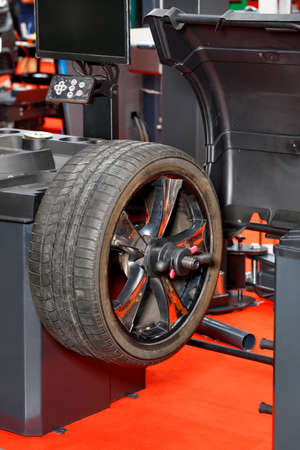1. What Is Tire Alignment?
Tire alignment, also known as wheel alignment, refers to adjusting the angles of your vehicles wheels to ensure they make proper contact with the road. It’s a crucial aspect of car maintenance that affects your vehicle’s handling, safety, and tire lifespan.
Understanding Tire Alignment
When your wheels are properly aligned, your car drives smoothly, maintains better fuel efficiency, and experiences fewer issues with uneven tire wear. Poor alignment, on the other hand, can lead to drifting, vibrations, and premature tire deterioration.
Key Alignment Angles
There are three main angles that technicians adjust during a tire alignment:
| Alignment Angle | Description |
|---|---|
| Camber | The inward or outward tilt of the wheels when viewed from the front of the car. |
| Toe | The inward or outward angle of the tires when viewed from above. |
| Caster | The angle of the steering axis that affects stability and steering response. |
Why Tire Alignment Matters
Proper alignment is essential for several reasons:
- Improved Handling: Keeps your car stable and responsive while driving.
- Better Fuel Efficiency: Reduces rolling resistance, allowing your car to use less fuel.
- Even Tire Wear: Prevents premature tire wear, saving you money on replacements.
- Safer Driving: Enhances traction and control, reducing the risk of accidents.
2. Signs Your Car Needs an Alignment
Proper tire alignment is crucial for maintaining a smooth and safe ride. When your car’s wheels are out of alignment, you’ll likely notice symptoms that indicate it’s time for an alignment check. Here are some common signs of misalignment:
Uneven Tire Wear
If your tires are wearing unevenly, it can be a clear indication that your alignment is off. Proper alignment ensures that all four tires make consistent contact with the road. If you notice excessive wear on the inner or outer edges of the tires, it’s time to get your alignment checked.
| Type of Wear | Possible Cause |
|---|---|
| Inner or outer edge wear | Camber misalignment |
| Feathering (tread wear in one direction) | Toe misalignment |
| Cupping or scalloping | Suspension issues and misalignment |
Steering Issues
When your car is out of alignment, you might notice that the steering wheel is off-center even when driving straight. Additionally, the vehicle may pull to one side, forcing you to constantly correct your direction. If you struggle to keep your car straight, your alignment likely needs adjustment.
Poor Handling and Instability
A misaligned vehicle can create handling problems, making your ride feel unstable or overly sensitive to road conditions. You might experience a loose or sloppy steering response, making it harder to maintain control while driving. This not only affects comfort but also poses a safety risk.
How to Identify Alignment Problems While Driving
- If your car drifts left or right without steering input, alignment may be off.
- If the steering wheel vibrates or feels shaky, it could indicate uneven tire wear or alignment problems.
- Check your tires regularly for unusual wear patterns, as they often reveal alignment problems early.
Why It’s Important to Get an Alignment
Ignoring alignment issues can lead to faster tire wear, decreased fuel efficiency, and compromised driving safety. If you experience any of these warning signs, schedule a professional alignment check to restore your car’s performance and prolong the life of your tires.
![]()
3. How Tire Alignment Affects Performance
Proper tire alignment plays a crucial role in your car’s overall performance. It impacts fuel efficiency, tire lifespan, and driving safety. Let’s break down how alignment affects each of these factors.
Fuel Efficiency
When your wheels are properly aligned, they roll smoothly with minimal resistance. However, misaligned wheels create additional friction, making your engine work harder and reducing fuel efficiency. Keeping your alignment in check can help you get the most out of every gallon of gas.
Tire Lifespan
Misalignment can cause uneven tire wear, leading to premature tire replacements. Proper alignment ensures even distribution of weight and pressure across all tires, extending their lifespan. Below is a comparison of how alignment impacts tire wear:
| Alignment Condition | Tire Wear Pattern | Expected Lifespan |
|---|---|---|
| Proper Alignment | Even wear | Longer lifespan |
| Misalignment | Uneven wear, bald spots | Shorter lifespan |
Driving Safety
Alignment directly affects how your car handles on the road. Misaligned wheels can cause drifting, poor steering response, and reduced traction, which can be dangerous, especially in wet or slippery conditions. Ensuring proper alignment helps your car drive straight and improves overall stability.
4. Types of Tire Alignment
Proper tire alignment ensures that your wheels are set to the right angles, helping your car drive smoothly and efficiently. There are three main types of alignment adjustments: toe, camber, and caster. Each one affects how your tires interact with the road and can impact handling, tire wear, and overall performance.
Toe Alignment
Toe alignment refers to the angle at which your tires point in relation to the centerline of your vehicle when viewed from above. There are two types of toe alignment:
| Type | Description |
|---|---|
| Toe-In | When the front edges of the tires are closer together than the rear edges. This setup improves straight-line stability but can cause tire wear on the outer edges. |
| Toe-Out | When the front edges of the tires are farther apart than the rear edges. This provides better cornering ability but may lead to inner edge tire wear. |
Camber Alignment
Camber refers to the inward or outward tilt of the tires when viewed from the front of the vehicle. Camber alignment is classified into three types:
| Type | Description |
|---|---|
| Negative Camber | The top of the tire tilts inward. This setup enhances handling in turns but can cause the inside of the tire to wear faster. |
| Positive Camber | The top of the tire tilts outward. It helps with stability but may lead to uneven tire wear on the outer edge. |
| Zero Camber | The tire stands perfectly vertical, ensuring even tire wear and a balanced driving experience. |
Caster Alignment
Caster refers to the angle of the steering axis when viewed from the side of the vehicle. It plays a crucial role in stability, steering, and cornering performance:
| Type | Description |
|---|---|
| Positive Caster | The steering axis tilts toward the driver. This improves high-speed stability and steering control. |
| Negative Caster | The steering axis tilts away from the driver. It can make steering easier but may reduce stability at higher speeds. |
Each of these alignment types plays a unique role in how your car handles and how your tires wear over time. Keeping your tire alignment in check ensures a safer and smoother driving experience.
5. When and How to Get an Alignment
When to Check Your Tire Alignment
Keeping your wheels properly aligned is essential for a smooth ride and even tire wear. But how do you know when it’s time for an alignment? Here are some common signs that indicate you might need to check your tire alignment:
- Your car pulls to one side while driving straight.
- The steering wheel is off-center when driving straight.
- Uneven or rapid tire wear.
- A shaking or vibrating steering wheel.
- After hitting a pothole or curb.
- After suspension or steering components are replaced.
How Often Should You Get an Alignment?
Even if your car seems fine, it’s a good idea to check alignment regularly. Below is a simple guideline for how often you should consider an alignment:
| Situation | Recommended Frequency |
|---|---|
| Regular driving with no issues | Every 12,000 to 15,000 miles or once a year |
| After hitting a pothole or curb | Check immediately |
| After replacing steering or suspension parts | Check after replacement |
| Uneven tire wear or steering issues | As soon as possible |
What to Expect During an Alignment Service
When you take your car in for a tire alignment, here’s what typically happens:
- Inspection: A technician will check your tire wear, suspension, and steering components.
- Measurement: Specialized alignment machines will measure your car’s current wheel angles.
- Adjustment: The technician will adjust the camber, caster, and toe angles according to your manufacturer’s specifications.
- Test Drive: Some shops may take your car for a road test to ensure a smooth and straight drive.
Types of Tire Alignments
Depending on your vehicle type and alignment issues, different types of alignments may be performed:
| Alignment Type | Description |
|---|---|
| Front-End Alignment | Adjusts only the front wheels; typically for older vehicles with a solid rear axle. |
| Two-Wheel Alignment | Adjusts front wheels only; common for cars with non-adjustable rear suspension. |
| Four-Wheel Alignment | Adjusts all four wheels; recommended for most modern vehicles with independent suspensions. |
How Long Does an Alignment Take?
A standard tire alignment usually takes about 45 minutes to an hour. However, if additional repairs are needed, it may take longer. Some factors that can affect alignment time include:
- Vehicle make and model
- Severity of misalignment
- Condition of suspension components
- Mechanic’s expertise and shop equipment
Making sure your wheels are properly aligned improves your car’s handling, extends tire life, and enhances fuel efficiency. If you experience any alignment-related issues, its best to have your tires checked as soon as possible.


